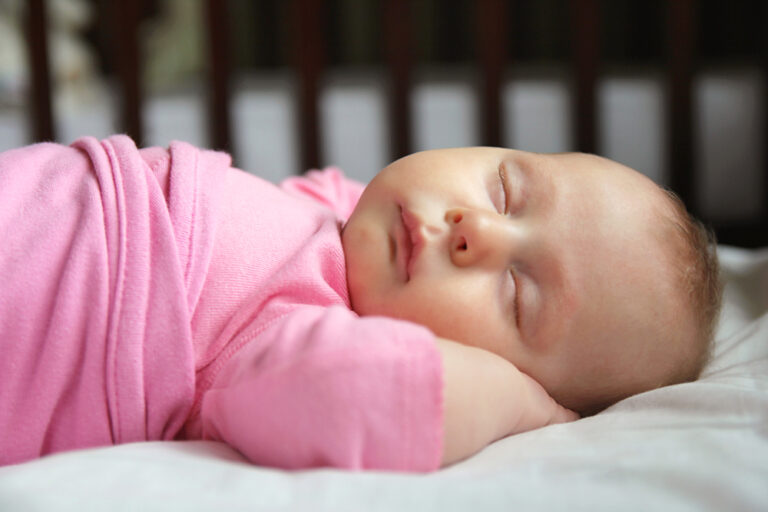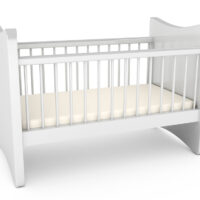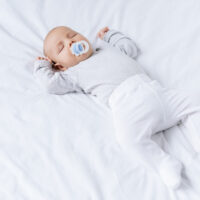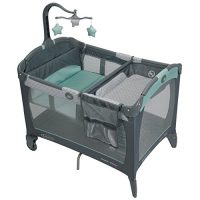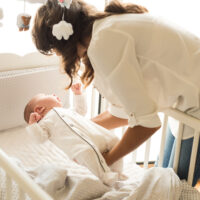If you are short on space, you may be considering using a mini crib for your little one. However, as your little one grows, you may ask yourself, “how long can a baby stay in a mini crib?” Most children should fit in a mini crib until they are one or two years old. Mini cribs tend to be about the same width as a regular crib but are shorter in length. You’ll want to make sure your child cannot climb out of the crib because once they can, it’s time to transition out of it.
Consider Age and Size
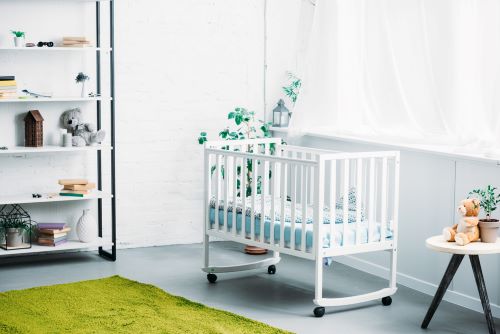
On average, most children can sleep in a mini crib until they turn two years old. Not only will they start to outgrow the crib, but they are much more likely to attempt climbing out. In addition, mini cribs have an average weight limit of 35 lbs vs. 45 lbs of regular-sized cribs.
Also, the length of time your baby can sleep in a mini crib will vary by the size of a child. Since mini cribs are about 38 inches in length, you don’t want to wait until your child reaches the same height to move them out of the mini crib.
Finally, if you opt for a convertible mini-crib, you’ll get much more use out of it as you convert it to a toddler or day bed. It will help lengthen the amount of time your baby can stay in a mini crib. In addition, buying a mini crib may help eliminate the need for a bassinet. If space is not on your side, the last thing you need is another piece of baby gear around your house.
RELATED: Is it OK To Leave Baby In Crib Awake?
What to Look For in a Mini Crib
Portability
Some mini cribs are on wheels, like the Babyletto Origami, making it easy to move them from one room to the next. This is perfect if you live in a small space and can’t have them sleep in the same spot every day. Perhaps, they usually sleep in the office, but you need the office space during the day. You can wheel the mini crib into the next room for their naps.
Since mini-cribs weigh less than a standard crib, you won’t have any problem zipping the crib from one room to the next. While it might become a tedious task, you sometimes have to do what works best for everyone in your family.
Ability to Convert
If you are hoping to get more bang for your buck, consider getting a mini crib that converts into a toddler bed. I highly recommend the Dream on Me Aden 4-in-1 if you are looking for something that will last more than a year or two. Not only is it priced exceptionally well, but it could end up being the only crib you need.
While it still limits the length of your bed, it’s a nice feature to have a crib that can eventually be used as a bed. You can either turn it into a toddler bed or use it as a headboard and footboard on a twin. Each of my kids sleeps in a twin, and it’s a good size for them. At some point, they may outgrow it, but even at 7, my oldest sleeps perfectly fine in a twin-sized bed.
Adjustability
Another feature to be on the lookout for is the ability to adjust the mattress level. If you plan to use the crib when your baby is a newborn, you will want to make sure the mattress is higher. This allows you to easily lay your baby down without feeling like you might drop them. Once they get older, you want to lower the mattress to prevent them from quickly climbing or falling off the sides.
You want to find a mini crib that has at least two adjustable settings. This will allow you some flexibility when it comes to mattress height. My kids were never climbers, but I know several friends with kids who loved to be little monkeys and climb right out of their crib. For obvious safety reasons, you want to make sure this is not an option for your child.
Quality Material
When it comes to cribs, solid wood is always an excellent option. Wood cribs are sturdier than metal cribs and more likely to stand the test of time. This is especially important if you plan to convert the crib into a bed once your child is old enough. While the mattress that typically comes along with a mini crib is thin, you can invest in a nicer one, like the Organic Dream, if you want to splurge a little.
If you plan on converting your crib into a bed, investing in a quality mattress will pass off in the long run. As your child gets older, they will sleep better if the mattress they are sleeping on is thicker and higher quality than a standard mini crib mattress.
RELATED: How to Get Baby to Sleep in a Crib
Crib vs Mini Crib
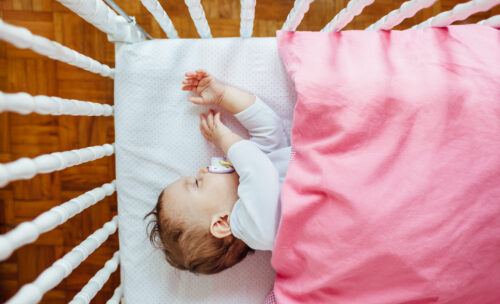
Before you make the purchase, it’s essential to understand the difference between mini and regular cribs. It will help you better decide if it’s the right fit for you. The most significant difference you will find between the two is in their size.
In general, a regular-sized crib is 52 inches in length and 28 inches in width, while a mini crib averages about 38 inches in length. The width tends to be roughly the same for both cribs; however, mini cribs can be more narrow. You will want to look at the exact measurements to ensure it fits your needs. I make tall babies and know they would have outgrown a mini crib pretty quickly. Regular cribs may be able to hold more weight too.
In addition, it can prove challenging to find the appropriate sized mattress and bedding for a mini crib. The beds tend to be thinner, so they may become uncomfortable as the child gets older. However, a newborn won’t be bothered by the thin mattress, as they only need a safe, flat space to sleep.
Finally, you’ll quickly notice a mini crib is lighter in weight than a regular crib. This will come in handy if you are unsure exactly where the baby will sleep long-term, and you may need to move it around your house.
RELATED: The Best Baby Cribs
FAQs – Mini Cribs
Is it worth it to buy a mini crib?
If you live in an apartment or small home, you may not have space for a full-sized crib. So, you may wonder if it’s worth the money if you’re only going to end up buying a regular crib in a year or so. It all depends on when you think you’d move your child into a bed. My kids all moved into a bed right before they turned two. If this will be the case for you, you should be fine using a mini crib.
However, if you don’t envision putting your child into a regular or toddler bed around 1-2 years of age, you will likely want to skip over the mini crib and buy a full-sized crib. In my opinion, the only benefit of a mini crib is saving space.
Finally, buying two mini cribs is much more economical than buying two regular-sized cribs if you have twins. In addition, you will save a good amount of space in their nursery, since with twins, you likely have duplicates of several items.
What’s the difference between a mini crib and pack-n-play?
While they seem similar, there are differences between a mini crib and pack-n-play. For starters, pack-n-plays tend to be used for traveling, whereas mini cribs are the permanent place your baby sleeps at home. A pack-n-play is typically sized between a mini crib and a regular crib. A pack-n-play may be a suitable option for your child if they have outgrown their mini crib but are not ready to sleep in a bed, and it does not make sense to buy a full-sized crib at this point.
Can you use bumpers in a mini crib?
While you may think bumpers help prevent bumps and bruises, it’s best to have your baby sleep in an empty crib. Unfortunately, bumpers put your baby at a higher risk of strangulation, suffocation, and SIDS. If you’re worried about a leg or arm getting stuck in the slats of the crib, that’s a far better situation than your baby getting their head stuck under a crib bumper.
Final Thoughts
As you can see, there is no precise time as to how long a baby can stay in a mini crib. It varies from one child to the next, but the average tends to be between one and two years of age. If space is a problem, then getting a mini-crib is a sensible option. You may have to switch to a bed sooner, but you’ll be grateful for the extra space you are given because of the smaller crib.
